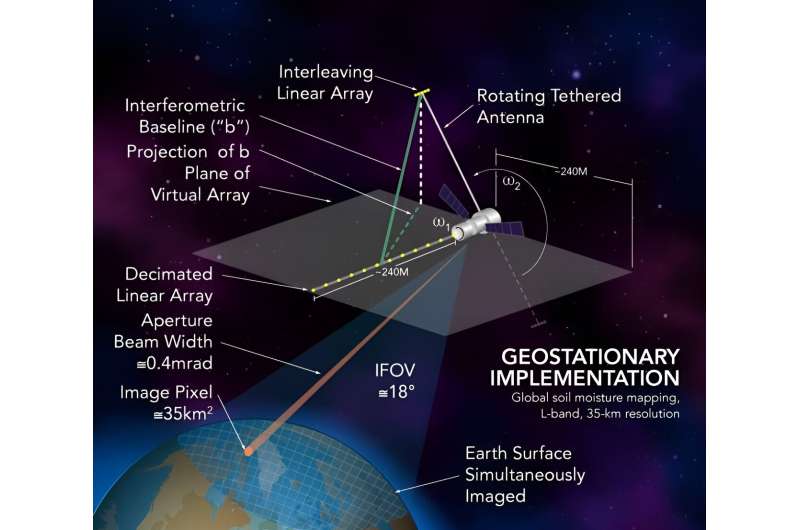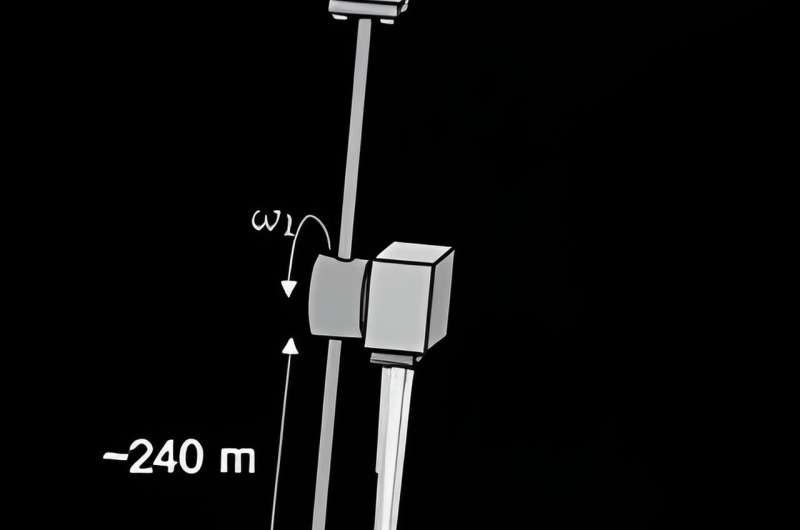
August 1, 2024 by Andy Tomaswick, Universe Today
Collected at: https://phys.org/news/2024-08-unique-combination-antennas-revolutionize-remote.html
Bigger antennas are better, at least according to researchers interested in geospatial monitoring. That’s because higher resolution in monitoring applications requires larger apertures. So imagine the excitement in the remote sensing community when a researcher from Leidos, a government consulting firm, developed an idea that dramatically increased the effective aperture size of a remote radio-frequency monitoring system simply by tying a rotating antenna to a flat “sparse” array.
That’s exactly what Dr. John Kendra did, and it has garnered him not only two NASA Institute for Advanced Concepts (NIAC) grants to advance the technology, but also a prize paper award at a technical conference on remote sensing. In other words, if implemented correctly, the Rotary-Motion Extended Array Synthesis (R-MXAS) technology could be a game-changer for remote sensing applications.
To understand why, it is best to understand the underlying concept of synthetic aperture radar (SAR). In a SAR system, multiple images of a single area are collected as a sensor moves past that area. Those images are then combined using a specially designed algorithm to create a single image composition. These images can see through clouds and are commonly used in remote sensing, especially in ground monitoring applications, such as tracking ocean levels.
R-MXAS is an implementation of a synthetic aperture imaging radiometer (SAIR), which combines the movement aspect of a typical SAR system and stitches together data from at least three separate antennas. One antenna is a large, 2D plane that is, in fact, a 1-D “sparse” antenna. Two antennas are attached to either end of a tether that rotates at a right angle to the flat plane.
https://www.youtube.com/embed/u2bUKEi9It4?color=whiteScott Manley explains the basics of Synthetic Aperature Radar (SAR). Credit: Scott Manley YouTube Channel
Data from those antennas are captured and combined in a specialized signal processing algorithm, some of which would occur in a remote sensing satellite, while some would have to occur on the ground. Those signal-processing algorithms effectively create an aperture area much larger than the sum of the physical components comprising it, which is precisely what remote sensing enthusiasts are looking for.
One particular application of this technology is ground moisture monitoring. Currently, there is a mission known as the Soil Moisture and Ocean Salinity (SMOS) mission, which ESA runs. It does an excellent job of monitoring overall soil moisture content at a resolution of about 35 km per “pixel.” But it does so from a low-Earth orbit, meaning it can only update those estimates once every few days.
That update rate is frustrating to end data customers, who would like to see a faster cycle time and a higher resolution to allow for more specific tailoring of responses to conditions on the ground.
R-MXAS can help with both of those desires. First, according to calculations by Dr. Kendra, it can map the same 35 km resolution from geostationary orbit, allowing it to monitor an entire hemisphere simultaneously and continuously. While this particular final report didn’t dive into the detail of how R-MXAS could improve the resolution to 5–10 km rather than 35km, the idea is addressed, at least in theory, to show that the same multi-antenna configuration could be used as a high-gain phased array to increase the resolution even more.

Given the novel nature of the idea and the enthusiastic acceptance by other researchers in the remote sensing community, R-MXAS was one of the lucky projects selected to receive a NIAC Phase II grant in 2019, immediately after its original Phase I grant in 2018.
A brief search shows the most recent paper as being from 2021 and no further adopted plans or missions that implement the concept, but it would seem that a project somewhere would do so. Given the wide variety of use cases for a technology such as R-MXAS, it remains to be seen what that use case might be.
More information: Rotary-Motion-Extended Array Synthesis (R-MXAS) FINAL REPORT: ntrs.nasa.gov/api/citations/20 … oads/20190002581.pdf

Leave a Reply